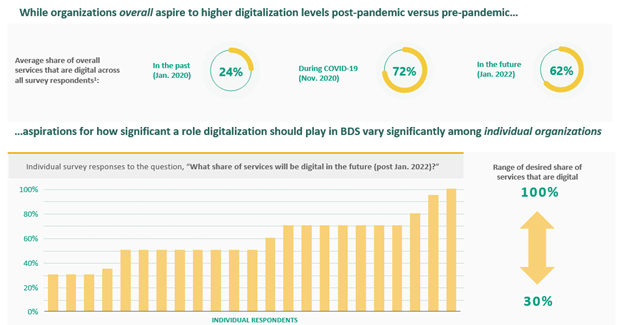Digital delivery: As we emerge from the pandemic, what level and type of digitalization makes sense for enterprise support organizations?
The COVID-9 pandemic accelerated a worldwide trend toward digitizing business advisory, coaching, training, and technical assistance services for small and growing businesses (SGBs). A recent ANDE survey of 30 enterprise support providers found the average share of digital services jumped from 24 percent pre-pandemic to 72 percent at the end of 2020 (see Figure 1 below). The aspiration for the long term is 62 percent, although organizations’ targets vary significantly.

Not all enterprise support services or contexts are suited to digitalization. For example, while delivering asynchronous trainings on specific topics using digital platforms is fairly easy, creating online spontaneous real-time peer-to-peer learning is harder. The choice of what enterprise support services to digitize and how to do so will depend on many factors, including types and locations of SGBs served, strategic ambition, and existing implementation capacity. Potential in these areas varies, so planning to achieve the right balance becomes key.
A new research report, Digital Delivery, a partnership among Dalberg, ANDE, and the Argidius Foundation, outlines three digitalization paths for enterprise support providers and notes the contexts and strategy behind choosing the right one (see Figure 2 below). Enhance organizations deliver client value through core offline service models supplemented by digital tools adopted for reasons such as to improve efficiency but that remain peripheral to the organizational strategy and business model. For Shift organizations, using online service delivery channels is part of their strategic focus. Although perhaps complemented by targeted offline service components, digital delivery is emphasized. Finally, Transform organizations have a digital-centric strategy and highly innovative business models, approaches, and tools for digital delivery. Their more extensive in-house capabilities and resources enable them to create their own technology platforms or products. Examples of each path are discussed below.

Balloon Ventures’ operations in Kenya and Uganda use the Enhance digitalization approach, supplementing their primarily in-person services with digital tools such as financial management or operational checklists. This suits them because their clients are generally not technologically advanced and may have limited ICT access, necessitating offline resources. Balloon Ventures’ supplemental use of digital tools increases the efficiency of their interactions with businesses, however, and helps them identify key areas for improvement while dedicating more time and resources to their core in-person capacity-building support.
Somo Africa takes the Shift route. At core a business accelerator, Somo supports social entrepreneurs working to transform low-income communities by providing them with business training, funding, market access, tailored advising, and mentorship. Forced by the COVID-19 pandemic to shift its mostly offline services online to webinars, podcasts, and gamified lessons via SMS and WhatsApp, Somo saw indications that learning outcomes improved as daily one-hour Zoom classes replaced weekly full-day in-person classes. Entrepreneurs found the material more digestible, motivating Somo to continue using online formats, reserving in-person classes for the most highly interactive sessions.
Finally, Africa Management Institute (AMI) took the Transform pathway. AMI has pivoted somewhat on audience and content scope, but through its digital platform and content-delivery application users can access customized learning journeys with downloadable tools and content. AMI’s vision was always to build a scalable digital-first model across Africa. Its business model has enabled it to scale through its own services and via licensing arrangements with others, like Acumen Fund, allowing intermediaries to use and customize AMI’s web and mobile apps, training content, and methodologies.
Drawing on lessons both from practitioners, and from leading digital organizations in other sectors, we unpack three key steps for effectively digitalizing, including tactical guidance, case studies, insights, exercises, and considerations by archetype. Learn how to help your organization on its own digitalization journey in this report.
